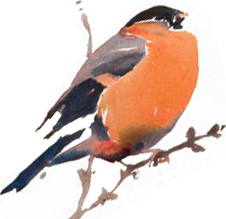It is all too rare that an entirely new space for birds and nature is created but at the beginning of June, the new wetland area at Musselburgh was finished. Local birders have waited a long time (about 25 years!) to see this come to fruition, and the results look, well, amazing! The photo (right), taken in June 2023, shows the view looking east across the new wetlands; North Berwick Law and the white of the Bass Rock can be seen in the distance.
“The ‘new wetland’ (it hasn’t got an official name yet) has transformed the old ash lagoon adjacent to the river mouth. The pools, islands and moat will provide new and exciting places for birds, with the primary aim being for roosting waders. The coming months and years will see the site mature and we can monitor the birds it attracts from the five new hides. This area is part of the Firth of Forth SPA and is designated primarily for its roosting waders, which the new wetland is designed to host.” Ian Andrews, SOC Lothian member
When the ‘old’ scrapes were created back in the 1990s, I took my sons on a YOC activity there to plant trees. As they dug out a spadeful of blackish ash, put in a handful of compost, then a tiny tree, I thought the saplings would be very lucky to even survive! But the trees grew just fine, and now provide good cover around the old scrapes and great wildlife habitat.

From ScottishPower Generation Wholesale pamphlet ‘Habitats & Heritage’
The whole area at Levenhall Links is reclaimed land handed over to East Lothian Council by Scottish Power in stages. Tons of infill created the 340 acres enclosed by the sea wall built in the 1960s. This was fly-ash from the nearby coal-fired Cockenzie Power Station (now completely dismantled) and many local birders will still remember the big hoses pumping jets of brown-grey slurry into the western-most lagoon. As an active lagoon this area attracted many birds including rarities such as Desert Wheatear, Kentish Plover and Western Sandpiper amongst others. In the years after the power station closed, that lagoon – flat, bare and desert-like – was of marginal bird interest, a notable exception being the winter of 2015/16 when up to 14 Short-eared Owls had a night roost there tucked into grassy tussocks.
The new wetland area has been ‘under wraps’ for the past year, with high fencing keeping everyone out as the diggers went about their task, so I’ve only just had my first look at it. The area now completed includes an outer scrub section, currently all Ox-eye Daisies and tree guards, with the base of grey ash visible here and there. The Ox-eye Daisies may seem to overshadow all else just now as they are an aggressive pioneer species, but as the scrub and grassy areas mature, other, less dominant species should move in as part of the natural ecological succession process.

The outer, scrub, area, Musselburgh, June 2023
A fully accessible tarmacked path encircles the inner section, which, I am very relieved to see, has been fenced with squared livestock fencing that should hopefully keep uncontrolled dogs out – an ongoing problem at the old scrapes. Five hides, utilitarian in design, give a raised view across a deep moat (again designed to prevent dogs) and to the wetlands.

Looking north out of one of the new hides, Fife can just be seen in the background. Musselburgh, June 2023
There are islands, pebbled beaches, an artificial Sand Martin wall, shallow water, deeper water… in fact, this whole mosaic should provide a wealth of nesting and roosting opportunities for a wide variety of birds. Even on this first early visit, I could see plenty of birds in the new wetland area: Oystercatchers, Curlews, Mallards, gulls of several species and Sandwich Terns. Currently, it does all look very raw, and signage is definitely needed, not to mention numbering or naming of the hides – otherwise how will I know which one to look out of when that ‘lifer’ arrives!
The wider Musselburgh area has a bird list of over 270 species, of which only a handful were not recorded at the lagoons; the latest addition, a Pacific Golden Plover, was seen on the old scrapes on 16 and 17 June of this year. Now, what will be the first mega for the new wetlands?!

Pacific Golden Plover, ‘old’ scrapes, Musselburgh June 2023
Rosie Filipiak
SOC Lothian member
Photos © Rosie Filipiak except Pacific Golden Plover © Ian Andrews




